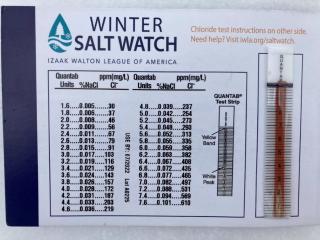Winter Salt Watch

Volunteers monitor, track road salt pollution
Road and sidewalk salt -- too much of a good thing?
With the onset of colder weather, the Izaak Walton League and local conservation groups have launched a new year of the Salt Watch program in Pennsylvania.
While road salt (sodium chloride) helps keep roads and sidewalks safe during icy weather, too much salt harms streams and water quality. The salt eventually washes into our watersheds where it damages the quality of drinking water and harms aquatic life in freshwater streams and lakes. The Salt Watch program uses volunteers to monitor levels of salt pollution in local waterways. This winter, the Izaak Walton League has distributed thousands of salt monitoring kits in Pennsylvania and 18 other states.
Free test kits can be ordered and shipped directly to you through the Izaak Walton League. This is a fun and educational activity to do with kids - and it is easy! Get the kit; stop by a local stream before a storm and collect a water sample; measure using test strip; and record the results, sharing your findings with Salt Watch and the EAC. A day or two after the storm, repeat the process. You can order your free test kit using the Salt Watch link above.
Don’t forget to upload your results to the national database and please share your findings with the EAC through the Township website.
The Upper Gwynedd Environmental Advisory Council (EAC) is a participant in the Salt Watch program and encourages Township residents to join, helping to refine this volunteer-based citizen science program.
Township Results from Winter of 2020-21
During the Winter of 2020-21, the EAC monitored a section of Haines Run, a tributary to the Wissahickon Creek. Baseline chloride levels for Haines Run were typical for a freshwater stream – <31 parts-per-million (ppm) – before a winter storm. Stark increases in chloride levels were observed – 67 ppm and 142 ppm – shortly after a snowstorm, and spiked to 290 ppm (toxic to aquatic life over a prolonged exposure) after a couple of days of snowmelt.
Submit YOUR results for inclusion by using the Township’s regular contact form.
Pennsylvania Results from Winter of 2019-20
Last winter, 2019-20, 81 Salt Watch results were submitted to the Izaak Walton League from the Philadelphia Metro Region. Of those results:\
- 37 percent yielded high readings (over 100 ppm)
- Of the high readings, 20 percent were at toxic levels (over 230 ppm)
Ideally, freshwater lakes and streams should have low to no salt content. Levels above 100 parts per million (ppm) exceed naturally occurring concentrations of salt. According to the EPA, concentrations above 230 ppm are toxic to aquatic life with prolonged exposure. Even in a relatively mild winter, these results showed some high salt readings for the region’s waterways, some higher than 230 parts per million (ppm). This suggests that road salt pollution has staying power and can harm aquatic life and drinking water for years after the salt hits the road. It also suggests that smarter salt application could make a big difference.
When submitted to the Izaak Walton League, the Salt Watch data from each collection site is loaded into a national database which is available to researchers and policymakers. The Izaak Walton League hopes that robust data collection over successive years will help establish reliable baseline information and pinpoint pollution problems so local authorities can address road salt problems and adopt better practices. Data and maps from the Salt Watch campaign can be found at www.iwla.org/saltwatchresults.
Resources
Read Road Salt: Way Too Much of a Good Thing in Outdoor America, Issue 1, 2020 and visit www.iwla.org/saltwatch. See www.iwla.org/road-salt-best-practices for details on state and local best management practices.

